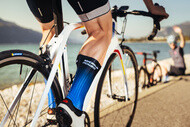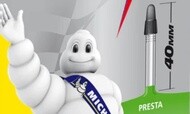
Tips and advice bicycle
You need to change your bicycle inner tube and don't know how to choose it? Our Michelin experts will guide you to make the right choice and explain how to fit it.
Which inner tube for your bike?
1 - What inner tube size do I need?
Look at the sidewall of your tyre. The size can be given in millimetres, inches or ETRTO measurements. To find out more about this, you can read our article "Understanding Bike Tyre Sizes". The inner tube for your bike must be compatible with the diameter and width of the tyre.

2 - Choose the right valve for you
If several valve options are offered, you will have to choose between a "STANDARD” valve (also called "Shrader") and a "PRESTA" valve.

STANDARD valve (Schrader)
The Shrader valve is more common. It has the same size as the car tyre valve, so you can adjust the pressure at a petrol station if you do not have an air pump.

PRESTA valve
The Presta valve is smaller and requires unscrewing the shell to inflate. As it is lighter, it is frequently used for racing bikes. Its thinness, however, also makes it more fragile.
How to fit a tubetype tyre (or tyre with tube) to your bike
Fitting an inner tube or a tubeless tyre to your bike seemed complicated? Follow our step-by-step mounting tips and discover other useful recommendations.
Fitting a standard tyre with an inner tube

1- Carefully check the condition of the rim. A rim in poor condition – broken or cracked – must be changed as it may cause leaks and be a danger to the user.

2- Check the condition of the rim band. A broken or cracked rim band around the rim should be changed. A rim band in poor condition is often the cause of punctures. To fit, superimpose the valve and rim holes and keep them in line.

3- Insert the 1st bead of the tyre into the rim.

4- Inflate the inner tube slightly to make it round and insert it into the tyre, starting with the valve. For latex inner tubes, do not forget to apply talc to facilitate positioning in the tyre.

5- Do the same for the second bead, always starting opposite to the valve and positioning the bead right into the rim well. Finish fitting at the level of the valve..
Watch our video on how to fit a road tyre with an inner tube:
Cookie Privacy
To watch this video, you'll have to accept some cookies from YouTube. Just click on the button below to open the cookie module.
HOW TO MOUNT A ROAD TIRE ?
Fitting a Tubeless tyre

1- Use a Tubeless Ready compatible or UST rim. Carefully check the condition of the rim. A rim in poor condition - broken or cracked – must be changed as it may cause leaks and be a danger to the user.

2- The rim must be lubricated all around the circumference to help the tyre slide when being fitted and, in particular, to ensure it is correctly centered. The lubricant to be used must be of the “soapy water” type or equivalent – no oil or grease.

3- Start by inserting the first bead opposite to the valve, taking great care to position the bead right into the rim well.

4- Do the same for the second bead, always starting opposite to the valve and positioning the bead right into the rim well. Finish fitting at the level of the valve.

5- Inflate the tyre until inserted, without exceeding the maximum pressure indicated on the sidewalls. Make sure the tyre is correctly centered. Adjust the pressure after a few kilometres.
Watch our video on how to fit a tubeless MTB tyre:
Cookie Privacy
To watch this video, you'll have to accept some cookies from YouTube. Just click on the button below to open the cookie module.
HOW TO MOUNT A TUBELESS TYRE ?
Tubeless Ready (MTB)
All MTB MICHELIN tyres in foldable bead are tubeless ready (Performance Line and Racing Line) and can be mounted without inner tubes, provide that :
- you use a Tubeless Ready-UST rim
- the maximum pressure indicated on the tyre sidewalls is not exceeded
- sealant liquid such as latex is added
- the tyre pressure is checked before every ride
Removal
To remove, unclip the beads around the rim and push them down into the rim well. Using tyre levers, taking great care, position one on either side of the valve (around 10 cm) and lift simultaneously to lever the tyre onto the rim flange. Move one of the levers all around the rim between the flange and tyre bead to remove the first bead completely. Remove the second one by hand.
MICHELIN Protek Max inner tube
In order to avoid punctures during your ride, the MICHELIN Protek MAX inner tube uses two different technologies:
- the presence of raised bumps and its compressing action causes the hole to naturally seal itself, or at least it reduces the loss of tire pressure
- the self-sealing liquid reaches the hole through the combined effect of the air inside the tube and the rotation of the wheel.
The hole could be partially sealed if the puncture is very large, and if the sidewalls have been punctured. If a puncture occurs, the object which has caused the puncture can be removed from the tire. The whole unit must nevertheless be functional, including rim, tire and inflated Protek Max inner tube, before and after the removal. This tube has not been designed to be repaired.

Caution during use :
Presence of sealing liquid inside the inner tube.
- If the Protek Max inner tube is accidentally ruptured, part of the sealing product may spill out; this product may cause irritation, therefore do not swallow and avoid all possible contact with the skin, mucous membranes and eyes. If swallowed or in case of contact with eyes, seek medical advice.
- Do not place the valve near your mouth.
Watch our video on how to fit a MICHELIN Protek Max inner tube:
Cookie Privacy
To watch this video, you'll have to accept some cookies from YouTube. Just click on the button below to open the cookie module.
Fitting Protek Max Inner Tube & Anti-Puncture Test - Michelin Bike
Recommendations
Tyre maintenance
To keep tyres as long as possible, you should check them before each ride. Remove any foreign bodies trapped in the rubber with a small screwdriver. Tyres should be washed with water because abrasive products can damage the fabric. Use small rubber repair patches on the inside of any small cuts through the ply. Rainwater makes flint in the roadway more apparent; this sharply attacks treads causing cuts that may perforate the casing.
Storage
When not in use, tyres should be stored in a cool, dark place. You should also avoid leaving your bike in the sun when not in use.
Puncture
In case of puncture, our recommendation is to the rim band each time the tyre is replaced, as well as when the inner tube is replaced..
Fitting direction for mountain bike tyres
Why a particular direction for fitting ?
The direction in which a tyre is fitted will enable the user to optimize the performance of the tyres in terms of braking and traction. In general, the front tyre is more involved in braking while the rear tyre gives maximum traction. The rolling direction is marked directly on the tyre by an arrow. The tyres are also marked “Front” and “Rear”.
Pressure curves
Pressure varies according to the weight of the rider (as for the road) but other parameters, such as the section, bike (front suspension or full suspension for mountain bikes) and use are important factors for the final choice.
Find the right tyre
Enter your Reg, vehicle or tyre size
We're searching for your tire...
Wait few seconds we're processing your photo

